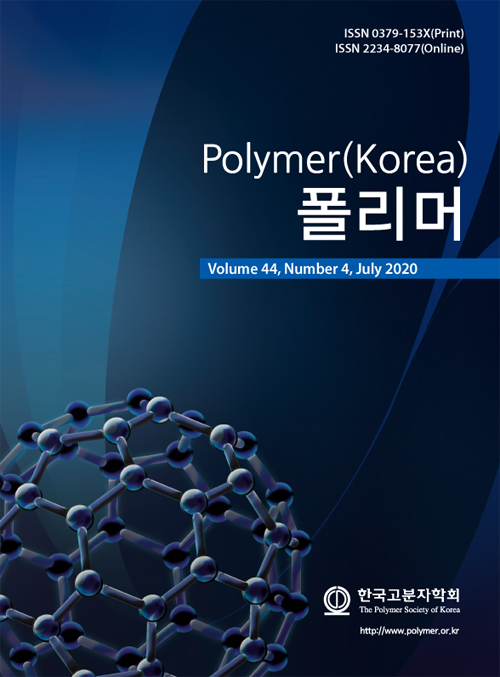- Characterization of Chitosan-Poly(ε-caprolactone) Hybrid Nanofiber Sheets Containing Insulin for Wound Dressings
Ga Young Jun, Young-Gwang Ko, Dongjin Kim, Oh Kyoung Kwon*, Won Il Kim**, Ho Yun Chung***, and Oh Hyeong Kwon†

Department of Polymer Science and Engineering, Kumoh National Institute of Technology, Gumi, Gyeongbuk 39177, Korea
*Gastric Cancer Center, Kyungpook National University Chilgok Hospital, Daegu 41404, Korea
**R&D Center, Wonbiogen Co., Ltd., Gumi, Gyeongbuk 39372, Korea
***Department of Plastic and Reconstructive Surgery, CMRI, School of Medicine, Kyungpook National University, Daegu 41944, Korea- 인슐린을 함유한 키토산-폴리카프로락톤 복합 나노섬유 시트형 창상피복재의 특성평가
금오공과대학교 고분자공학과, *칠곡경북대학교병원 위암센터, **(주)원바이오젠, ***경북대학교 의과대학 성형외과, 세포외기질연구소
The construct for wound
dressings should be designed to promote the regeneration of the epidermal and
dermal layers while ensuring biocompatibility and physical strength with
protecting the wound from external infectious bacteria. In this study,
nanofibrous sheet type wound dressings were prepared by electrospinning of a
mixture of chitosan, poly(ε-caprolactone) (PCL) and insulin. The
nanofiber sheets according to the mixing ratio were analyzed for
physicochemical properties through structural analysis, elemental composition,
tensile test, biodegradability, drug release behavior, antibacterial activity,
cell proliferation behavior, and wound healing ability via in vivo
animal testing. As the content of chitosan increased, the elongation of the
nanofiber sheets decreased, and the biodegradability, drug release ability, and
antibacterial activity tended to increase. In animal experiments and
histological analysis, the accelerated wound healing rate of the
chitosan-PCL-insulin nanofibrous sheet was verified when compared to other
nanofiber sheets, and thus it is expected to be used as a wound dressing
material.
창상피복용 구조체는 생체적합성과 물리적 강도가 보장되고
외부의 감염균으로부터 상처부를 보호하면서, 상피층과 진피층의 재생을 촉진할 수 있도록 설계되어야 한다. 본 연구에서는 키토산과 poly(ε-caprolactone)(PCL) 및 인슐린 혼합물의 전기방사를 통해 나노섬유 시트형 창상피복재를 제조하였다. 혼합비율에 따른 각 나노섬유 시트의 미세구조분석, 원소조성분석, 인장시험, 생분해성, in
vitro 약물방출능, 항균능, 세포증식
거동, in vivo 동물실험을 통하여 물리화학적 특성분석 및 창상치유능을 평가하였다. 키토산의 비율이 증가할수록 시트의 변형률이 감소하였고, 생분해성, 약물방출능 및 항균능은 증가하는 경향을 보였다. 동물실험 및 조직분석결과에서
키토산-PCL-인슐린 나노섬유 시트는 다른 나노섬유 시트보다 촉진된 상처회복률을 보였으며 창상피복용
소재로의 활용이 기대된다.
Keywords: chitosan, poly(ε-caprolactone), insulin, nanofiber, wound dressing
- Polymer(Korea) 폴리머
- Frequency : Bimonthly(odd)
ISSN 0379-153X(Print)
ISSN 2234-8077(Online)
Abbr. Polym. Korea - 2022 Impact Factor : 0.4
- Indexed in SCIE
 This Article
This Article
-
2020; 44(4): 549-558
Published online Jul 25, 2020
- 10.7317/pk.2020.44.4.549
- Received on Mar 23, 2020
- Revised on Apr 3, 2020
- Accepted on Apr 6, 2020
 Correspondence to
Correspondence to
- Oh Hyeong Kwon
-
Department of Polymer Science and Engineering, Kumoh National Institute of Technology, Gumi, Gyeongbuk 39177, Korea
- E-mail: ohkwon@kumoh.ac.kr









 Copyright(c) The Polymer Society of Korea. All right reserved.
Copyright(c) The Polymer Society of Korea. All right reserved.